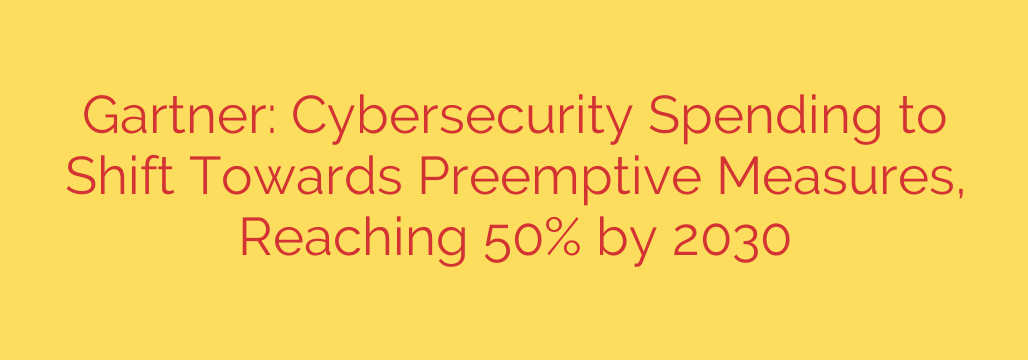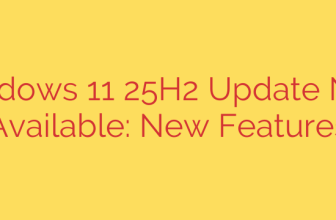
The Future of Cybersecurity: A Major Shift Towards Proactive Defense
For years, the world of cybersecurity has operated on a “detect and respond” model. Security teams have been digital firefighters, racing to extinguish blazes after they’ve already started. While necessary, this reactive approach is becoming unsustainable in the face of increasingly sophisticated threats and ever-expanding digital footprints.
A fundamental shift is underway. The future of cybersecurity isn’t about building better fire alarms; it’s about building fireproof structures from the ground up. Industry analysis points to a dramatic change in spending priorities, moving away from reaction and towards prevention.
The Limits of a Reactive Strategy
The traditional approach to cybersecurity is heavily weighted towards identifying and reacting to threats as they happen. This includes tools for intrusion detection, endpoint response, and security information and event management (SIEM). While these tools are crucial, relying on them alone creates a state of perpetual crisis.
Security teams are often overwhelmed by a constant flood of alerts, leading to burnout and “alert fatigue.” More importantly, this model means organizations are always one step behind attackers. By the time a threat is detected, the damage may already be done—data may be stolen, systems may be compromised, and trust may be eroded.
The reactive model simply can’t keep up. The attack surface for the average organization has exploded with the adoption of cloud services, IoT devices, and complex supply chains. Trying to detect every possible threat across this vast landscape is a losing battle.
The New Paradigm: A Prevention-First Mindset
A new strategy is emerging, one focused on preemptive action and continuous threat exposure management. This approach proactively identifies, prioritizes, and resolves security weaknesses before they can be exploited by attackers.
The change in focus is expected to be dramatic. By 2030, it is projected that half of all cybersecurity spending will be dedicated to proactive, prevention-focused initiatives. This is a monumental increase from today, where such measures account for only a small fraction of security budgets.
This isn’t just about buying different tools; it’s about adopting a new philosophy. Instead of asking, “How do we respond to an attack?” forward-thinking leaders are asking, “How can we make an attack impossible or irrelevant in the first place?”
Understanding Continuous Threat Exposure Management (CTEM)
At the heart of this proactive shift is the concept of Continuous Threat Exposure Management (CTEM). This is not a single product but an ongoing program designed to give organizations a comprehensive and attacker-centric view of their security posture. A successful CTEM program typically involves a continuous cycle of five key stages:
Scoping: This involves defining the scope of your digital and physical assets. It’s about understanding what is visible and potentially vulnerable—from on-premise servers and cloud infrastructure to employee laptops and operational technology.
Discovery: In this stage, security teams use various tools to continuously scan and identify vulnerabilities, misconfigurations, and other weaknesses across the defined scope. This goes beyond a simple annual penetration test to provide a real-time view of potential exposures.
Prioritization: Not all vulnerabilities are created equal. This critical step involves analyzing discovered weaknesses in the context of your business. Which vulnerabilities pose the greatest risk? Which are most likely to be exploited? Prioritization helps focus limited resources on the threats that matter most.
Validation: Once a critical risk is identified, it must be validated. This stage involves confirming that the vulnerability is indeed exploitable and poses a genuine threat to the organization. This can be done through controlled penetration testing or by using breach and attack simulation tools.
Mobilization: This is the action phase. Once a threat is validated and prioritized, security and IT teams must work together to remediate the issue. A key part of mobilization is ensuring clear communication and streamlined workflows to fix problems quickly and efficiently.
Actionable Steps for a More Proactive Security Posture
Transitioning from a reactive to a proactive security model requires a conscious effort. Here are several steps business and security leaders can take to prepare for this shift:
- Audit Your Current Security Spend: Analyze your budget. How much is currently allocated to reactive tools (detection, response) versus proactive ones (vulnerability scanning, attack surface management)? This will provide a clear baseline.
- Map Your Attack Surface: You can’t protect what you don’t know you have. Invest in tools and processes for Attack Surface Management (ASM) to gain a complete inventory of all your internet-facing assets.
- Prioritize Ruthlessly: Shift your team’s focus from chasing every alert to systematically identifying and fixing the weaknesses that pose the biggest business risk. Use threat intelligence to understand how attackers are operating.
- Foster a Culture of Prevention: Reward teams for proactively discovering and fixing vulnerabilities, not just for heroically responding to incidents. Security should be a shared responsibility, integrated into IT and development processes from the beginning.
The move towards proactive defense is more than a trend—it’s a necessary evolution for survival in the modern threat landscape. By focusing on preventing attacks before they happen, organizations can build a more resilient, efficient, and ultimately more secure future.
Source: https://www.helpnetsecurity.com/2025/09/23/preemptive-cybersecurity-solutions-shift/








